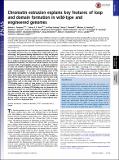Chromatin extrusion explains key features of loop and domain formation in wild-type and engineered genomes
Author(s)
Sanborn, Adrian L.; Rao, Suhas S. P.; Huang, Su-Chen; Durand, Neva C.; Huntley, Miriam H.; Jewett, Andrew I.; Bochkov, Ivan D.; Chinnappan, Dharmaraj; Cutkosky, Ashok; Li, Jian; Geeting, Kristopher P.; Gnirke, Andreas; Melnikov, Alexandre; McKenna, Doug; Stamenova, Elena K.; Aiden, Erez Lieberman; Lander, Eric Steven; ... Show more Show less
DownloadSanborn-2015-Chromatin extrusion.pdf (3.447Mb)
PUBLISHER_POLICY
Publisher Policy
Article is made available in accordance with the publisher's policy and may be subject to US copyright law. Please refer to the publisher's site for terms of use.
Terms of use
Metadata
Show full item recordAbstract
We recently used in situ Hi-C to create kilobase-resolution 3D maps of mammalian genomes. Here, we combine these maps with new Hi-C, microscopy, and genome-editing experiments to study the physical structure of chromatin fibers, domains, and loops. We find that the observed contact domains are inconsistent with the equilibrium state for an ordinary condensed polymer. Combining Hi-C data and novel mathematical theorems, we show that contact domains are also not consistent with a fractal globule. Instead, we use physical simulations to study two models of genome folding. In one, intermonomer attraction during polymer condensation leads to formation of an anisotropic “tension globule.” In the other, CCCTC-binding factor (CTCF) and cohesin act together to extrude unknotted loops during interphase. Both models are consistent with the observed contact domains and with the observation that contact domains tend to form inside loops. However, the extrusion model explains a far wider array of observations, such as why loops tend not to overlap and why the CTCF-binding motifs at pairs of loop anchors lie in the convergent orientation. Finally, we perform 13 genome-editing experiments examining the effect of altering CTCF-binding sites on chromatin folding. The convergent rule correctly predicts the affected loops in every case. Moreover, the extrusion model accurately predicts in silico the 3D maps resulting from each experiment using only the location of CTCF-binding sites in the WT. Thus, we show that it is possible to disrupt, restore, and move loops and domains using targeted mutations as small as a single base pair.
Date issued
2015-10Department
Massachusetts Institute of Technology. Department of BiologyJournal
Proceedings of the National Academy of Sciences of the United States of America
Publisher
National Academy of Sciences (U.S.)
Citation
Sanborn, Adrian L. et al. “Chromatin Extrusion Explains Key Features of Loop and Domain Formation in Wild-Type and Engineered Genomes.” Proceedings of the National Academy of Sciences 112.47 (2015): E6456–E6465. © 2015 National Academy of Sciences
Version: Final published version
ISSN
0027-8424
1091-6490